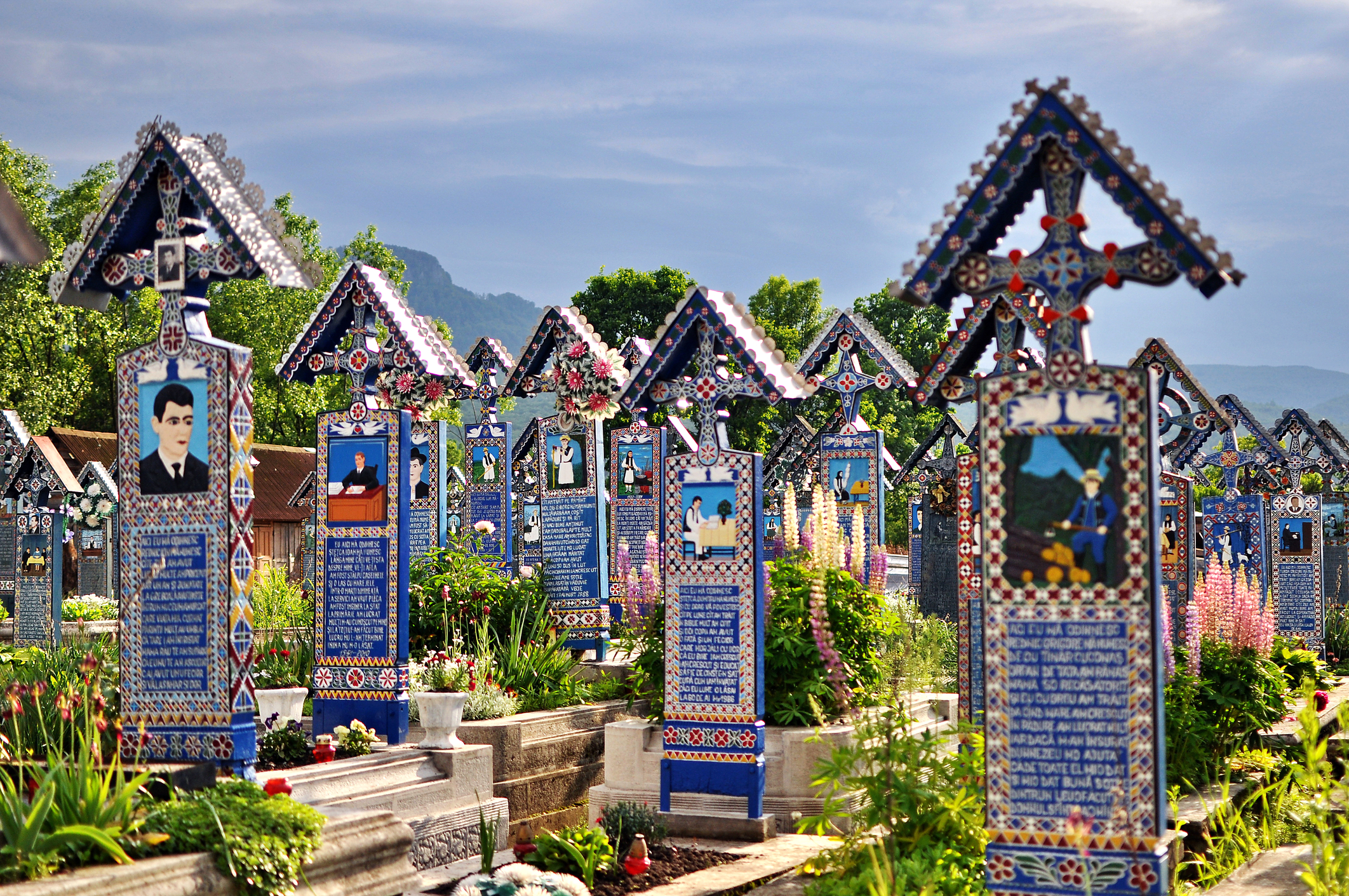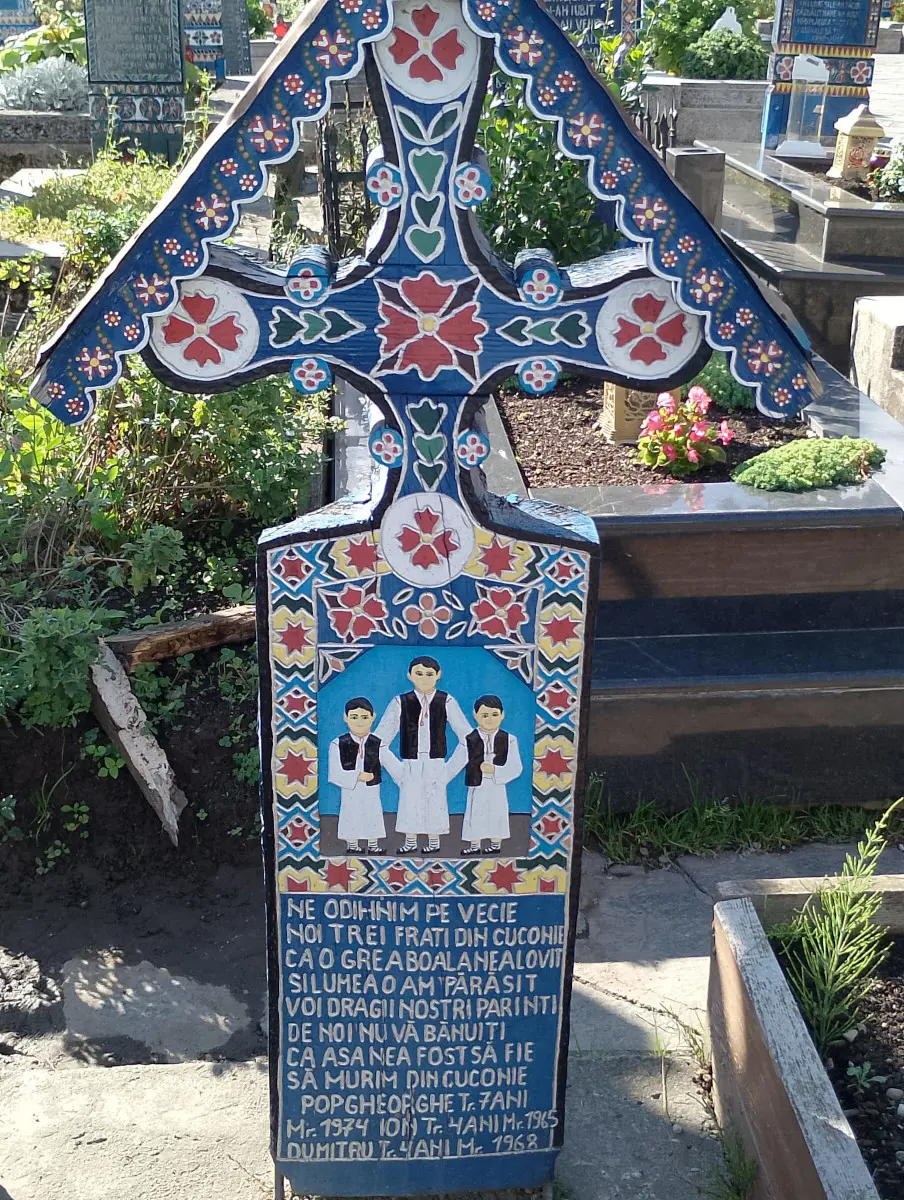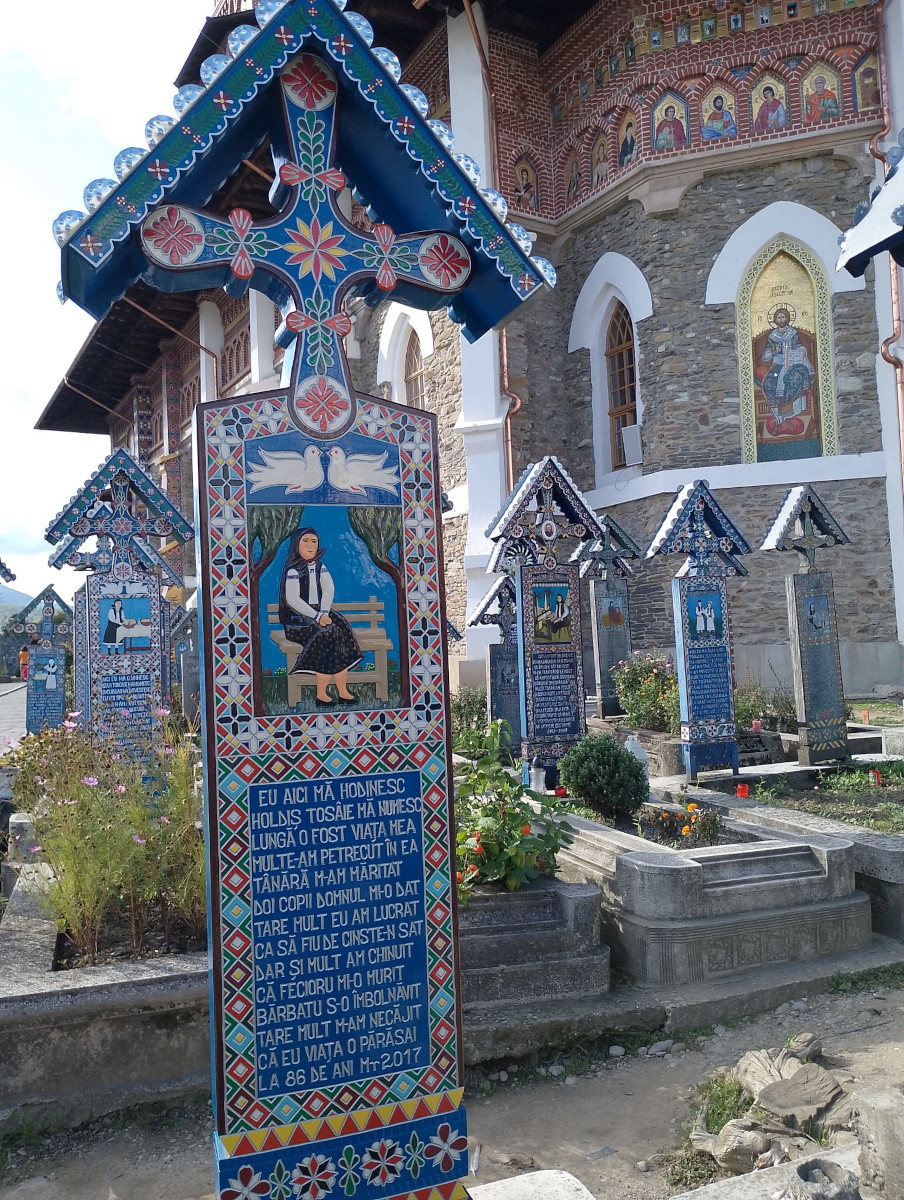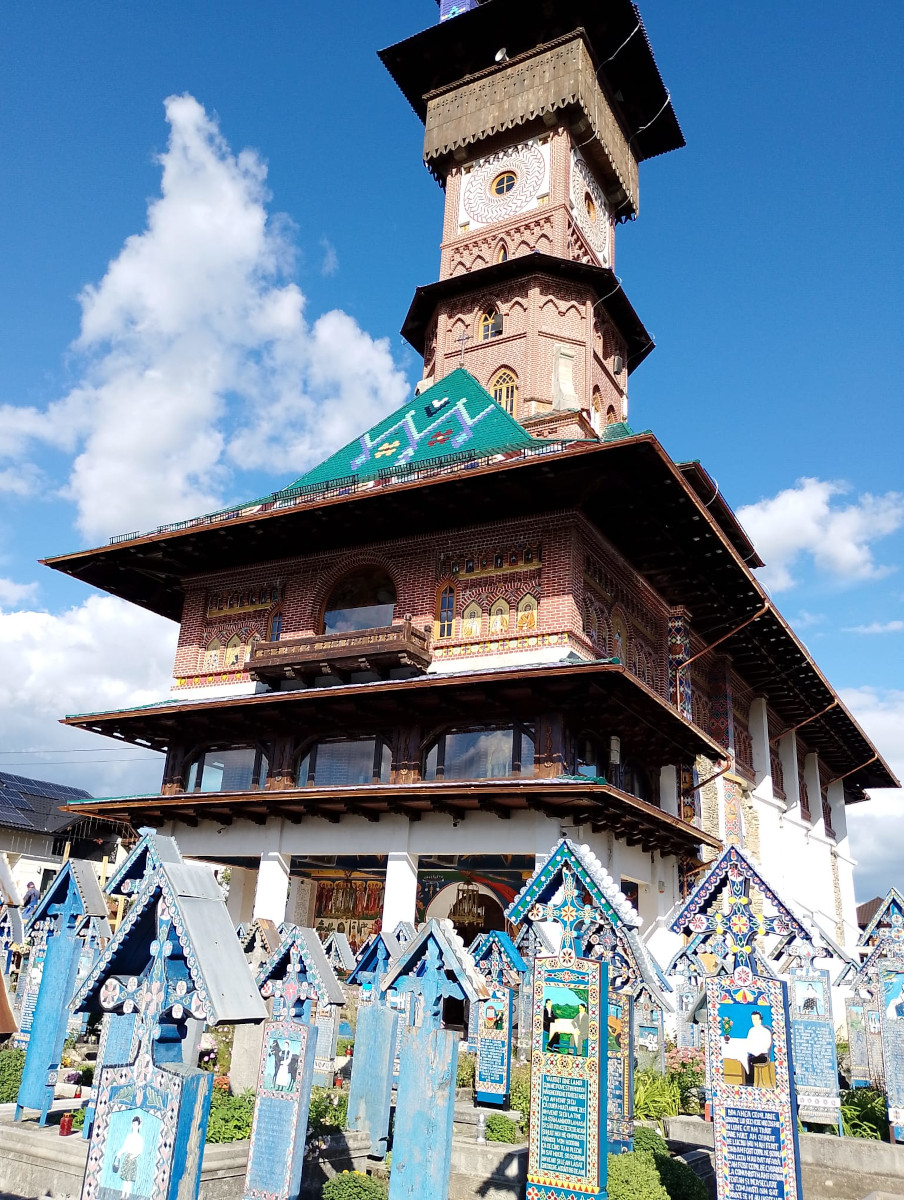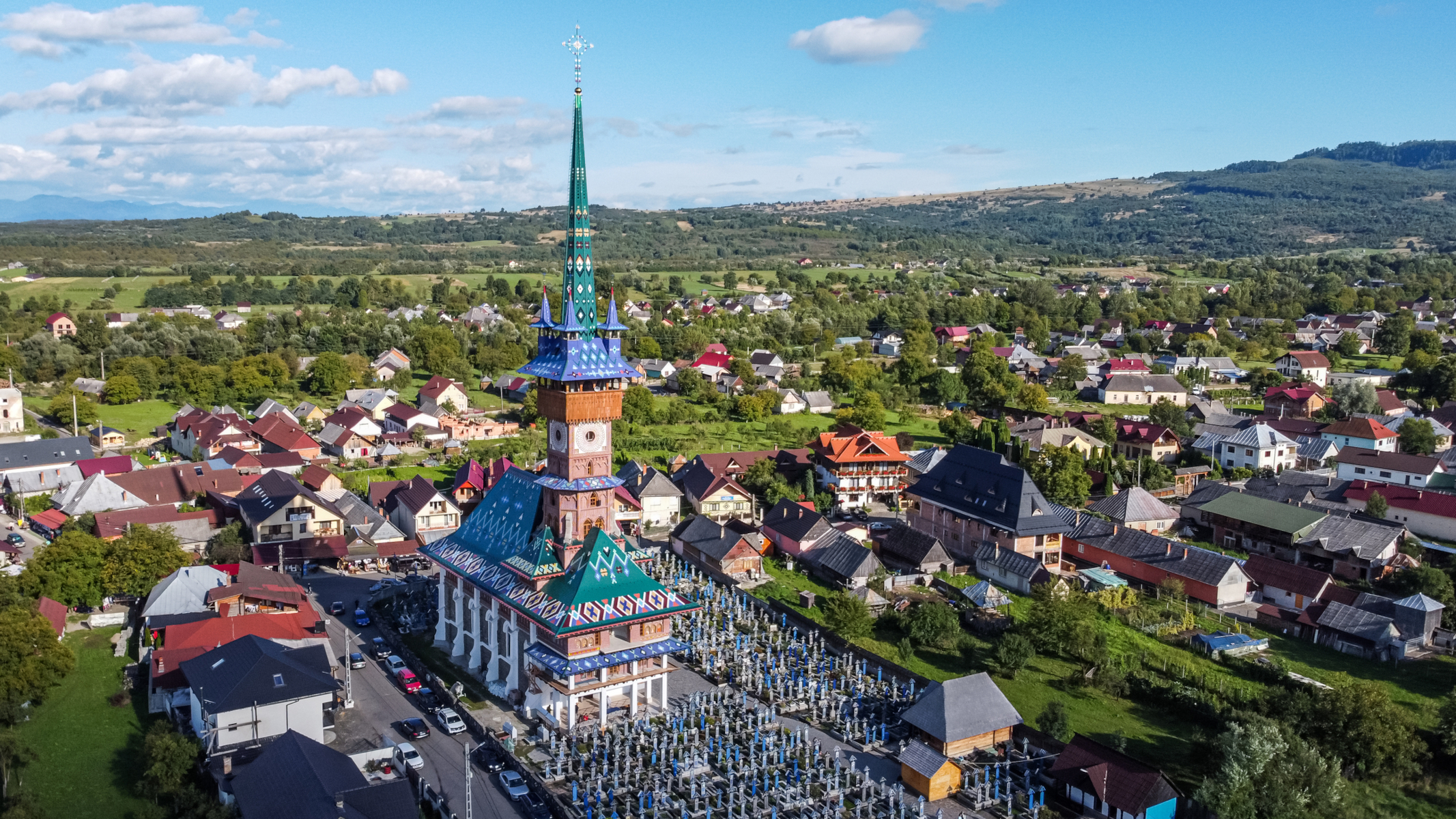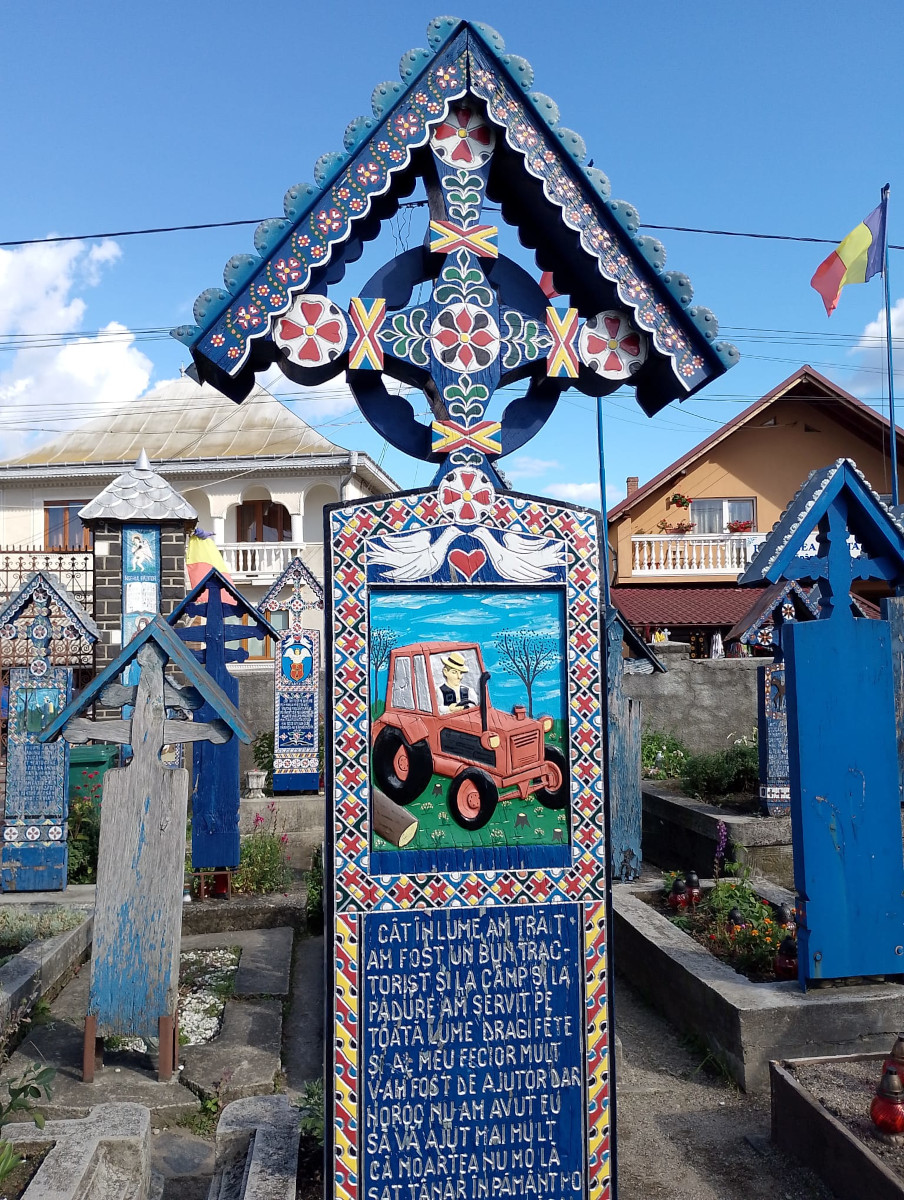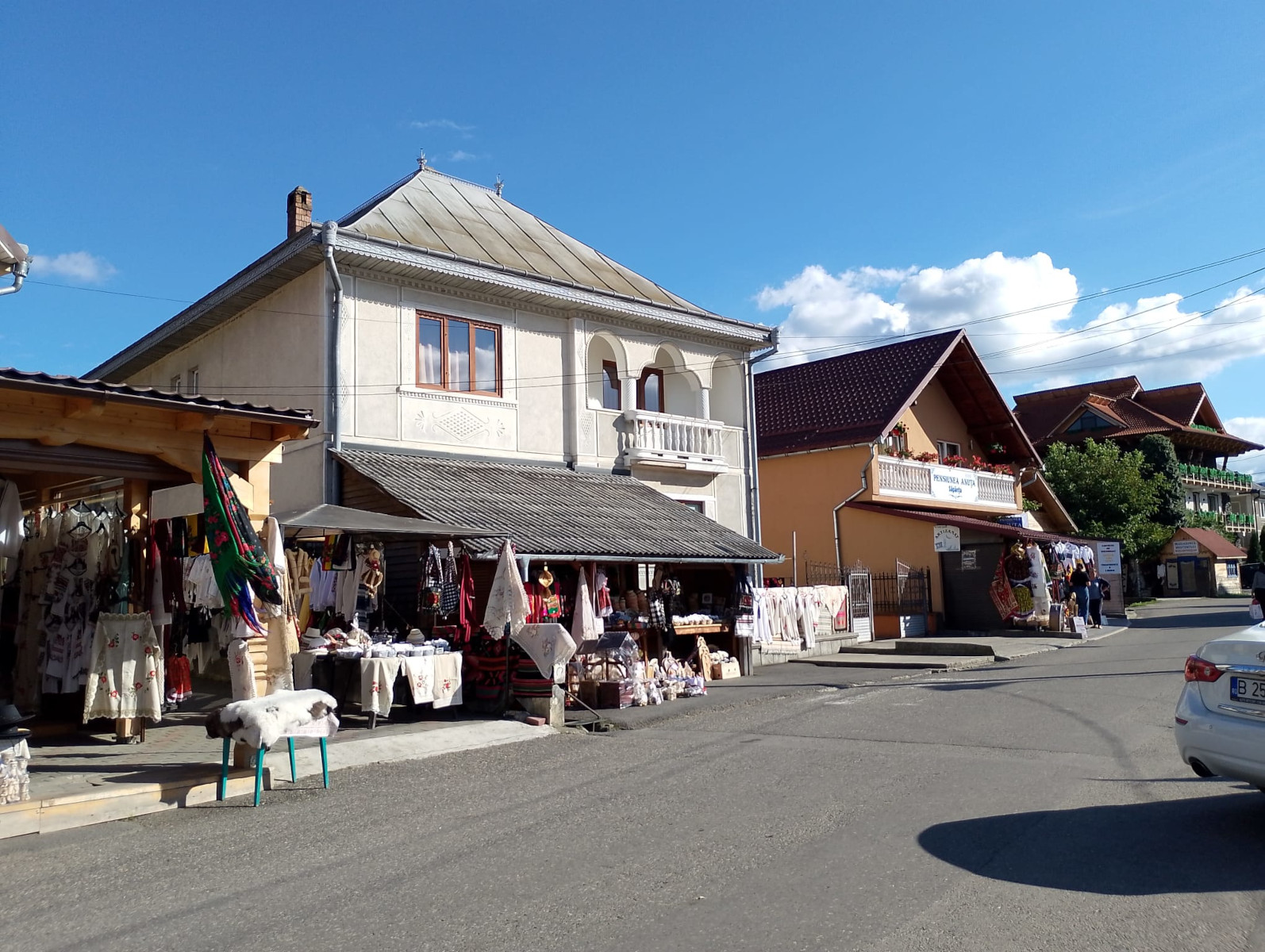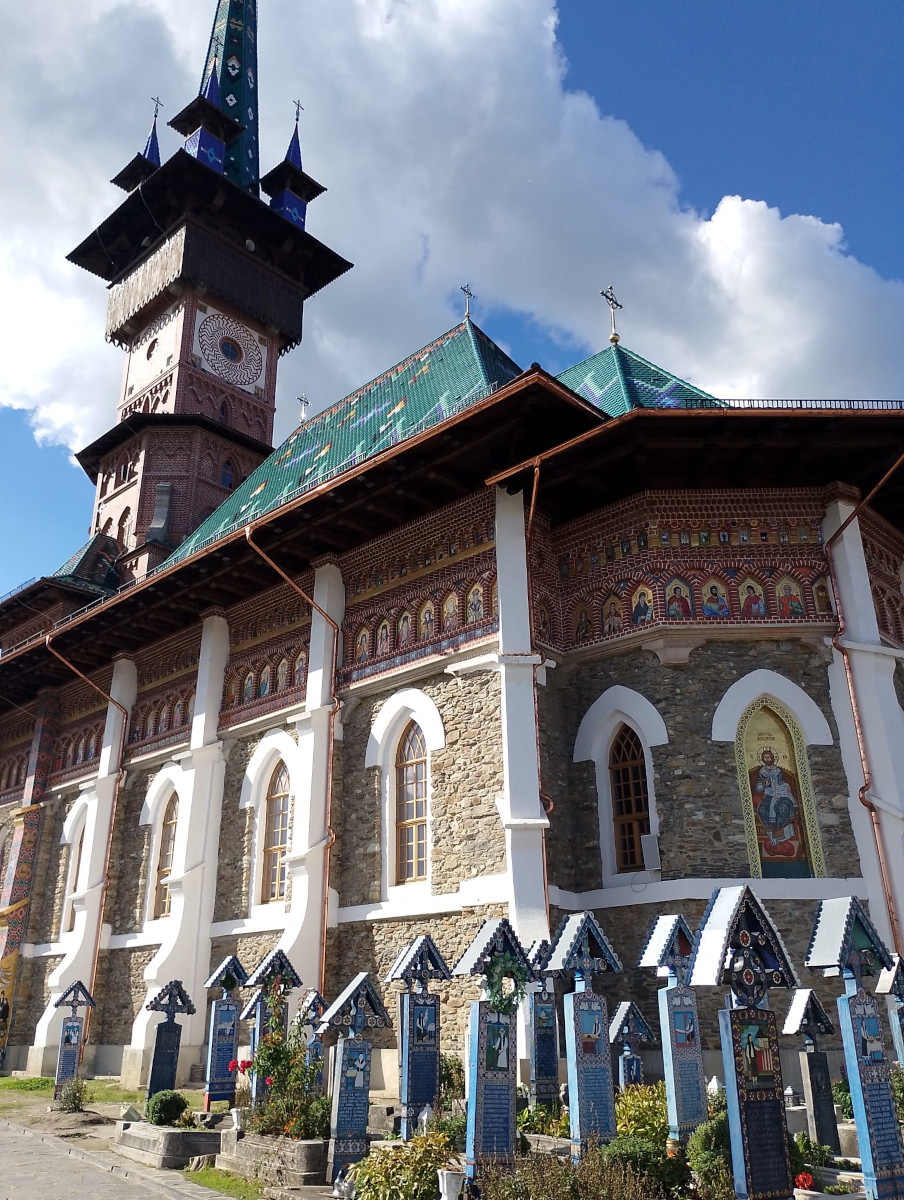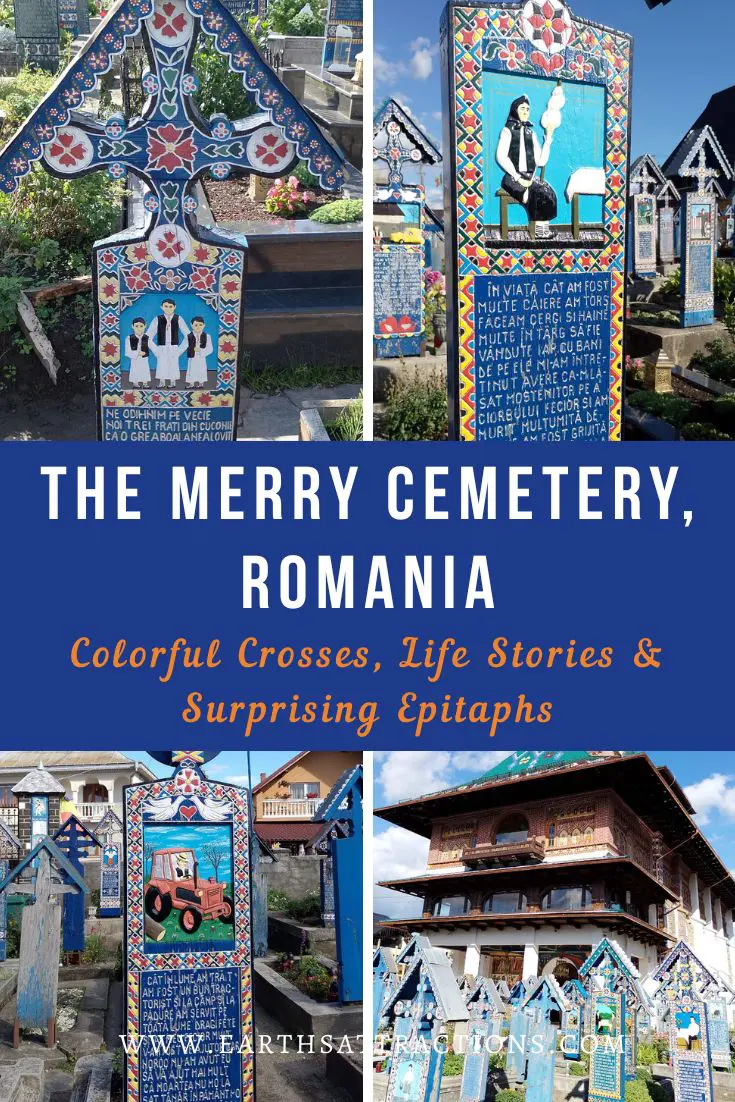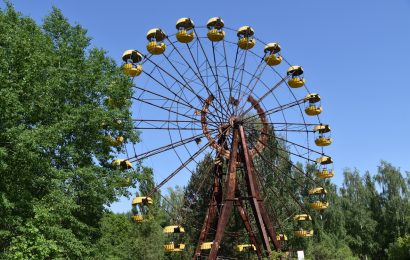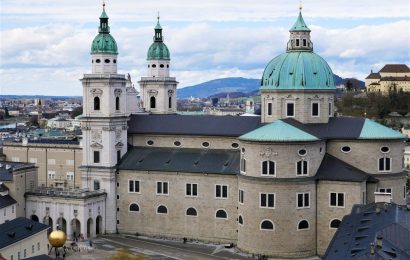When I first heard about a place called the Merry Cemetery in Săpânța, Romania, I honestly wasn’t sure what to expect. A cemetery that’s “merry”? How could a place usually associated with grief, loss, and solemnity be cheerful? But when I finally visited this small village in Maramureș, in northern Romania, I quickly realized why this cemetery is unlike any other in the world.
I visited it 20 years ago on our honeymoon. Yes, I know how that sounds – but we were on a vacation in Vatra Dornei and we took day trips to all the famous places in the area, including this one (on a day-tour to the famous monasteries in the area).
ID 57626822 ©Andrei Stancu | Dreamstime.com
For those of you who do not know it, The Merry Cemetery in Săpânța (Cimitirul Vesel) is not just a burial ground – it’s a cultural landmark, a living museum of wit, humor, folk art, and community spirit.
Instead of gray tombstones and somber inscriptions, you’ll find colorful wooden crosses painted in bright blues, (other colours are present too: reds, greens, and yellows), each decorated with folk motifs and often featuring witty epitaphs or naïve-style paintings about the deceased’s life – or sometimes their cause of death.
Walking among these crosses feels surreal. You laugh, you think, you reflect. And most importantly, you understand that in this corner of Romania, death is not just an end – it’s part of life’s story, told with honesty, humor, and art.
In this article, I’ll take you through the history, uniqueness, cultural context, and my own impressions of the Merry Cemetery. If you’re planning a visit, or even just curious about one of Europe’s most unusual cemeteries, this guide has everything you need.
As I lost my photos, the images in this article are from Mirela, a dear friend who visited Sapanta Merry Cemetery a week ago (apart from the 2 from Dreamstime).
A Brief History of the Merry Cemetery
The story of the Merry Cemetery of Săpânța begins in the 1930s with Stan Ioan Pătraș, a local woodcarver, sculptor, and painter. Pătraș had the idea to break away from traditional gravestones and instead craft brightly painted wooden crosses, each with a short poem or epitaph telling the story of the person buried there.
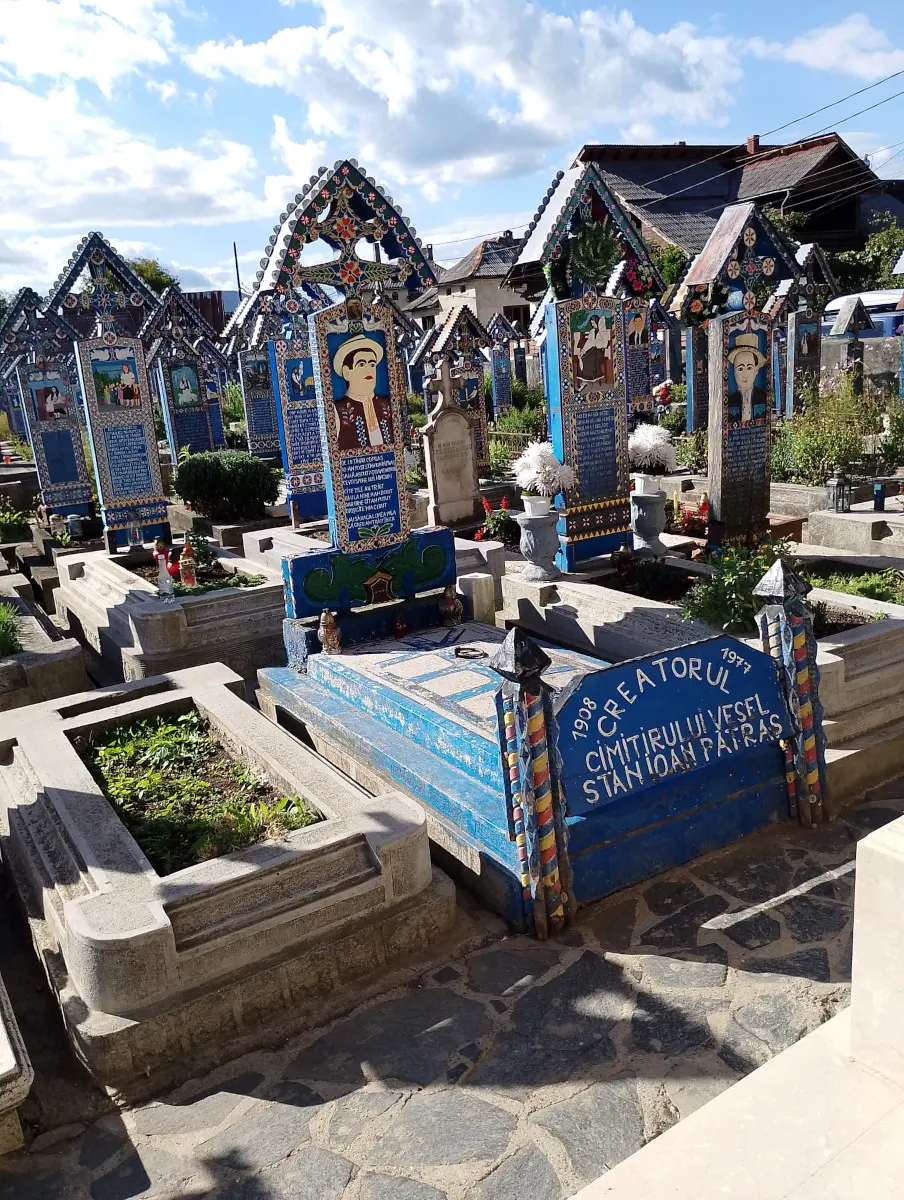
Some epitaphs are humorous, gently poking fun at the person’s quirks.
Others are brutally honest, revealing flaws or the cause of death.
Many are deeply touching, telling stories of hardworking lives, family ties, or local tragedies.
By the 1960s, Pătraș’s work had gained recognition beyond the village, and today the cemetery is home to over 800 colorful crosses, all continuing his tradition. After Pătraș’s death in 1977, his apprentice, Dumitu Pop Tincu, carried on the craft, ensuring that this unique folk art survives.
The art continues today, and I hope they will manage to pass it over to the next generation too!
In 2005, UNESCO recognized the Merry Cemetery as part of Romania’s intangible cultural heritage, highlighting its unique blend of art, humor, and local tradition.
What Makes the Merry Cemetery Unique
When you walk through Săpânța’s Merry Cemetery, the first thing that strikes you is the explosion of color. Unlike the dark, heavy atmosphere of most cemeteries, this one is filled with cheerful hues – especially the famous “Săpânța Blue”, a bright sky-blue background used on most crosses.
Here’s what makes it truly special:
Colorful Crosses and Naïve Folk Art
Each wooden cross features an image carved and painted in a folk-art style. These images often depict the deceased at work, doing something they loved, or even the manner in which they died.
For example, you might see a woman baking bread, a shepherd with his sheep, or a tragic accident illustrated with brutal honesty.
Witty and Honest Epitaphs
The short poems or verses inscribed on the crosses are the heart of the Merry Cemetery. Some are funny, others bittersweet, and a few downright blunt. They are written in the first person, as if the deceased is speaking to you from beyond the grave.
Examples include lines like:
“Here I rest. I loved my car too much, and it killed me.”
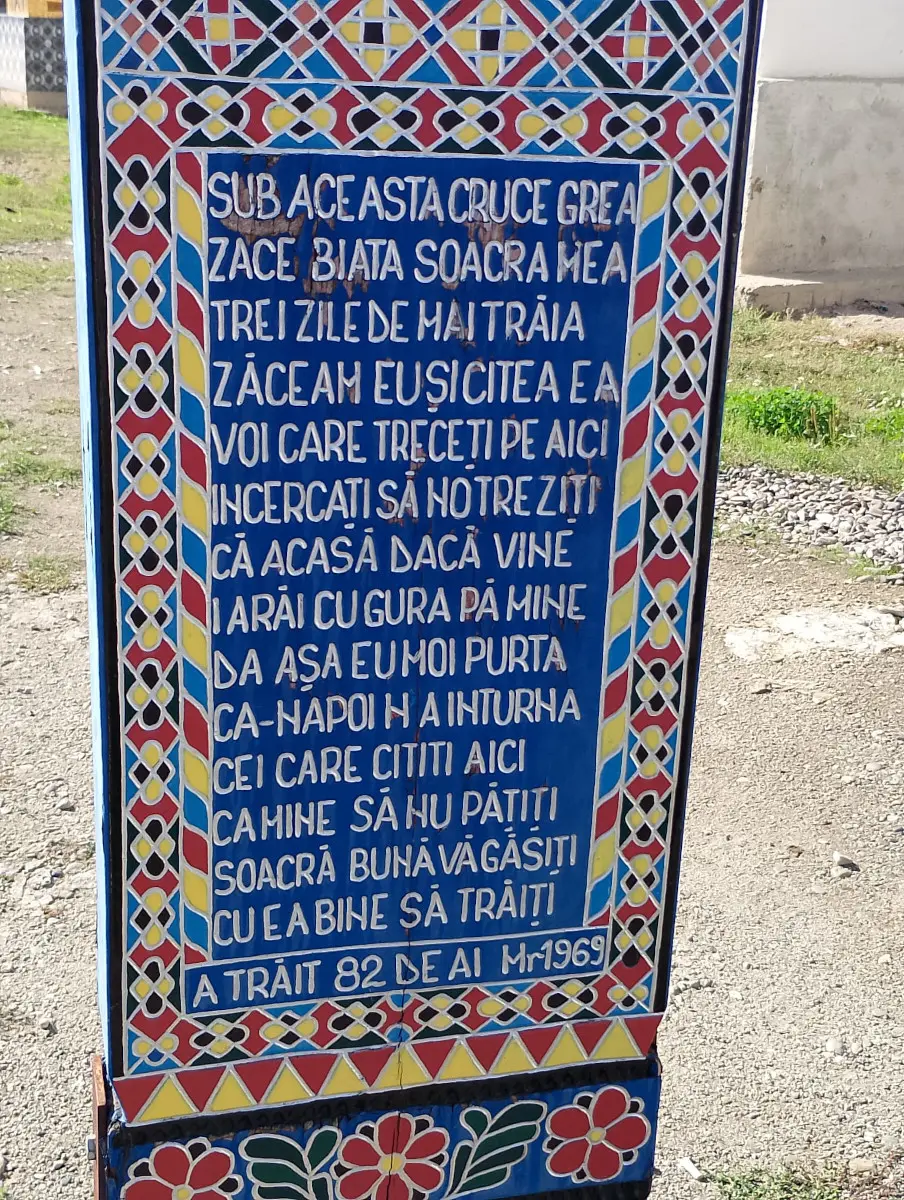
Translation:
“Underneath this heavy cross
Lies my poor mother-in-law.
If she had lived three more days,
I’d be lying here, and she’d be reading this.
You who pass by, try not to wake her up,
For if she comes back home,
She’ll start nagging at me again.
So I’ll carry her this way,
And never bring her back.
You who read these lines,
May you not suffer like me.
Find a good mother-in-law,
And live well with her.”
“She lived 82 years. †1969”
This epitaph is one of the best-known examples that show why the cemetery is called “merry.” It’s witty, playful, but also a candid look at everyday family tensions.
But there are sad ones too:
“We rest here forever,
We three brothers from childhood.
A grave illness struck us,
And we left this world.
You, our dear parents,
Do not blame yourselves,
For it was destined to be this way,
That we should die in childhood.”
Pop Gheorghe, age 7 (d. 1974)
Ion, age 7 (d. 1965)
Dumitru, age 7 (d. 1968)
These epitaphs bring out a smile, surprise, or even discomfort or deep sadness – but they always make you think.
A Philosophy of Life and Death
At its core, the Merry Cemetery reflects a philosophy of acceptance. Death is inevitable, so why not face it with honesty, humor, and a celebration of life rather than fear and sorrow?
A Personal Story Behind Every Cross
What struck me most during my visit was that in the Merry Cemetery, a cross is never just a cross. It’s not simply a name, a date, and a generic inscription like you often see elsewhere. Instead, each one tells a life story, a mini-biography carved and painted in wood, meant to be read and remembered for generations.
Through the naïve folk art, the painted portraits, and the witty or emotional epitaphs, you get to know something real about the person who rests there – what they loved, how they lived, or even how they died. It feels like every cross is a snapshot of a human life, condensed into a few verses and an image that captures their essence.
Visiting the cemetery, I realized I wasn’t just walking among graves. I was meeting people – farmers, teachers, mothers, children, soldiers – ordinary lives preserved in extraordinary ways.
Some of their stories made me smile, others made me cry, but all of them made me pause and reflect.
The Merry Cemetery ensures that the past isn’t reduced to just names and dates. Instead, it reminds us that every life, no matter how long or short, has meaning and leaves a trace worth remembering.
Is It Really “Merry”?
When I first stepped inside, I wasn’t sure how to feel. Can a cemetery really be “merry”?
The truth is, it’s a mix of emotions. The “merriness” doesn’t mean the place mocks death. Instead, it’s about celebrating life and facing death without fear.
It’s merry because (some of) the epitaphs make you smile
One of the most unforgettable aspects of the Merry Cemetery is the playfulness of the epitaphs. Written in the first person, as though the deceased is speaking directly to you, they often include witty remarks, humorous confessions, or even sarcastic commentary on their own lives.
Reading them feels like hearing someone’s unfiltered last words – sometimes cheeky, sometimes brutally honest, but always human. I remember stopping in front of a cross where the “voice” of the deceased joked about their love for drinking and how it had led them to an early grave. Instead of sadness, I caught other visitors smiling. And I smiled while reading some of the epitaphs too.
It’s merry because the colors and artwork feel alive, not dark
Another reason the Merry Cemetery truly deserves its name is the explosion of color that greets you at every turn. For me, this is THE reason I believe this cemetery can be called merry. It is not gray and sad.
Bright blues, vivid reds, cheerful yellows, and bold greens dominate the crosses, each stroke of paint bringing life to a place usually associated with muted grays and blacks. The famous “Săpânța Blue,” a vibrant sky-blue background used on many crosses, has become a symbol of the cemetery itself.
Walking among them, I didn’t feel weighed down by gloom – instead, the crosses seemed to celebrate the lives of those who had passed.
The naïve folk-style paintings, often depicting the deceased doing something they loved – working in the fields, weaving, playing an instrument – made the cemetery feel more like a gallery of life stories than a resting place for the dead.
But it’s also sobering – many crosses tell tragic stories of young lives cut short, accidents, or hardships
Of course, not every story in the Merry Cemetery is merry. Some of the most striking epitaphs are also the saddest, recounting tragic deaths from accidents, illness, or war. Or children dying young. I had tears in my eyes reading these stories.
Seeing a painted cross of a young woman holding her child, with an inscription about her untimely passing, stopped me in my tracks. Another showed a man killed in a car crash, the image painted with blunt honesty. There was another one about a man who was in an elevator, in a foreign country. The elevator crashed.
These stories remind visitors that behind the humor and the bright colors lies a deep respect for the struggles and sorrows of life in Maramureș.
For me, these sobering moments balanced the smiles and emphasized again that the Merry Cemetery isn’t about mocking death – it’s about telling life’s story truthfully, with all its joys and tragedies woven together.
So yes, it’s merry, but in a uniquely Romanian, Maramureș way, where humor and tragedy intertwine naturally in folk culture.
Visiting the Merry Cemetery: What to Expect
Location
The Merry Cemetery is located in Săpânța, a small village in Maramureș County, northern Romania, close to the Ukrainian border.
Atmosphere
ID 232258880 ©Vladescu Bogdan | Dreamstime.com
When you walk in, you’re greeted not just by the colorful crosses but also by the wooden church at the center. The church itself is part of the experience, decorated in the same style of folk art and colors.
You’ll often see tourists wandering quietly, smiling as they read epitaphs, sometimes even chuckling softly. There’s an unspoken agreement: respect, but also acceptance of the humor.
Best Time to Visit the Merry Cemetery
Spring and summer bring the brightest atmosphere, with flowers adding even more color. In winter, under the snow, the crosses look magical.
We visited in autumn, on a weekday. There weren’t many visitors – people were at their jobs, and most of the people in the cemetery were tourists. But not crowded.
How Long to Spend
I recommend at least 1–2 hours. You’ll want to slowly read the epitaphs, admire the artwork, and take in the unique vibe.
While the epitaphs are in Romanian, you can use the Google Translate app – picture feature – and translate them.
Personal Impressions
For me, the Merry Cemetery was one of the most surprising places I’ve ever visited. I expected something quirky – because it is promoted as merry everywhere, but I found something much deeper.
I smiled at some epitaphs, felt moved by others, and admired the artistry on every cross. More than once, I stopped to reflect: how would I want my life summed up in a few witty lines? Would I prefer humor, honesty, or poetry?
Walking here makes you think not just about death, but about how you live.
Practical Tips for Visiting the Merry Cemetery
Entry Fee: There’s usually a small fee (a few lei) to enter. It is around 2 $ or 2 euros.
Photography: Allowed, but be respectful. Don’t treat it like a theme park.
Guides: Local guides can explain the stories in English, which makes the experience richer.
Souvenirs: You can buy miniature wooden crosses or books with epitaph translations – or many other traditional souvenirs.
Combine with Other Attractions: Maramureș is full of wooden churches (many UNESCO sites), traditional villages, and beautiful countryside.
Why You Should Visit the Merry Cemetery
If you’re traveling to Romania, especially northern Romania – Maramures area, the Merry Cemetery is a must-see because:
- It’s one of the most unique cemeteries in the world.
- It offers a window into Romanian humor, culture, and folk art.
- It makes you reflect on life in a lighthearted way.
- It’s a UNESCO-recognized cultural treasure.
- It’s unlike anything you’ll find anywhere else.
Conclusion
The Merry Cemetery of Săpânța is more than just a quirky tourist attraction – it’s a philosophy in wood and paint. It teaches us that death isn’t just something to fear or mourn but something to acknowledge with honesty, humor, and humanity.
When you visit, you’ll smile, laugh, maybe even shed a tear, and you’ll walk away with a new perspective on how we tell our life stories.
If you’re planning a trip to Romania, especially the Maramureș region, don’t miss the Merry Cemetery. It’s a once-in-a-lifetime experience that will stay with you long after you’ve left.

